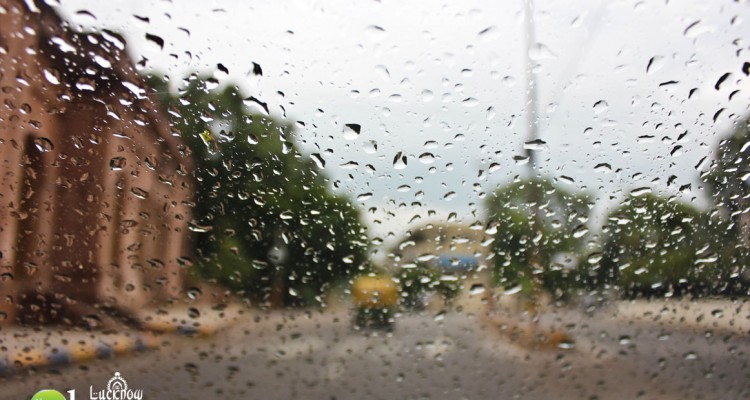As Rana Safvi waits for the monsoons to thunder down, she goes back to her childhood in Lucknow
Kitne dilkash hain mere mulk ke mausam,
inn mein Husn ki baat karein, ishq par israar karein
Nur e Mehboob se raushan karein aankhon ke chiraagh
Phuul ki tarah se zikr lab-o-rukhsar karein
Here Ali Sardar Jafri reflects on Ritusamhaar, a poem by Kalidas that highlights the importance and beauty of every Indian season.
Whenever the rain clouds gather my memories immediately take me to my childhood and the carefree and spontaneous rain dances in the courtyard. These are universal memories and I doubt there’s anyone who hasn’t got wet in the rain. Memories are now crowding in and I remember the saawan celebrations, which were organized when we were in college. Swings were put up on trees and songs sung with each swing:
Jhoole pad gaye daari daari, naache man ka mor,
sakhi ri, saawan hai ghan ghor
Saawan or monsoons is all about joy, songs and dancing as rain bearing clouds provide the much-needed succor from heat and provide water for agriculture. India being an agricultural society its festivals, songs and traditions are linked to the seasons, which are a source of livelihood for many. Rice the staple food of many in India is planted during this season and while growing up I remember seeing fields full of women singing while planting it in fields which had rain water up to their ankles.
As Mir Taqi Mir said:
Rut hai barsaat ki bahut pyaari Maujzan jheele’n nadiya’n saari
Khet dhaano’n ke lahlahe shadaab Kar rahe hain nazar ki dildaari
Saundhi
The aroma of wet earth hovers around in anticipation. Did you know that saundhi is called petrichor in English? However many perfumes or fresheners we may buy nothing beats the first saundhi smell that comes with the first rain fall. Nowadays of course we stay in air-conditioned homes where windows are rarely opened but the first rain is still welcomed with open arms and open windows by those living in huts, high rises or havelis.
In fact traditional perfumes associated with the aroma of this season are itr-e-gil or itr-e-khaki or saundhi mitti and wet earth that is still made in Kannauj the perfume capital of India. It’s even used in the summers as a cure for nosebleeds and high blood pressure caused by intense heat.
The people’s poet Nazeer Akbrabadi wrote:
Yeh rut hai ki jis mein khurd-o-kabir khush
hain Adna, gareeb, muflis, shah-o-wazir khush hain
Maashooq shad-o-khurram, aashiq aseer khush hai
Jitney hain ab Jahan mein sab ai Nazir khush hai
Kya kya machi hai yaaro’n barsaat ki bahaare’n
Henna
I was talking to friend Veejay Sai, an expert on the musical and cultural traditions of India. He told me of another very important aspect of saawan. Veejay said that the menhdi or henna leaves bloom at monsoon time and that is why the red colour of menhdi is associated with this season when women are engaged in the hectic activity of applying henna.
That thought brings to mind the scene from the 1978 film Junoon where Dipti Nawal and Nafisa Ali are shown enjoying the rains in a mango orchard..
Khil gaye hatheli par mehndi ke boote Lachkat jhoolan pe daar
Dhaani chunar sar pe naa thahre Choodiyaa’n kare’n jhankaar Saawan ki aayi bahaar
The Nawabs of Awadh hosted mehfils where visitors sang songs in praise of saawan. Thumri is an important semi-classical musical genre that was born and nurtured in Awadh. It was sung during the season. Swings were put up on mango trees to enjoy the moisture laden breeze after the still heat of the summer months and those who were experts in creating beautiful patterns on the hands of maidens with crushed menhdi leaves were most in demand at this time of the year.
India is a veritable treasure house of a rich musical and cultural tradition inspired by all the seasons enjoyed by the region.
Apart from the songs of joy there are soulful lyrics expressing the anguish of the separation from home, hearth and loved ones of migrants and landless labourers who are forced to earn a living far away from home. Their condition inspired songs of love and longing and of these my favourite is a now almost forgotten genre of kajri of semi classical singing of the thumri family.
The word kajri is from kajal or kohl which the maiden applies to beautify her eyes in preparation to meet her lover, hoping that the clouds will also unite the skies with the earth in the much desired rainfall.
The kajri style of singing is said to have originated in Mirzapur, Eastern UP. Originally sung by a woman named Kajli whose lover did not return to her, the dejected woman is said to have thrown herself at the feet of Goddess Kajmal, imploring her to bring him back.
Ghir ke aaye badariya Rama
Shyaam bin sooni sajariya hamaar.
Mohammed Afzal wrote:
Raseeda barsram hangaam-e-barsaat
Sajan pardes hain, haihaat! haihaat!
During the monsoons young brides and wives were often sent back to their parents home while husbands were busy with the planting and till in go fields. Far away from the beloved the lover found solace with her sakhis or friends who teased her brooding moodiness.
My favourite and the most popular one when I was growing up was:
Kaise khelun jaiyyo saawan maa kajariyaa
badariya ghir aayi goriyaa
The unlucky ones left alone in her sasural with unfriendly, hostile in laws would moan:
Amma mere Baba ko bhejo ji, ke saawan aaaya
Beti tera Baba tau boodha ri, ke saawan aaya
Immortalized by Amir Khusrau, the verse never fails to bring tears to the eyes at the thought of a lonely girl looking up at the gathering of dark clouds and seeing a similar darkness in her own life.

Anything for monsoons!
Have you ever wondered why Indians will do anything to seduce the monsoons to come?
Monsoons are so important to all agriculture dependent people here that they will do anything to seduce the clouds to burst. Even if it means ploughing parched fields without wearing any clothes.
There are age old rituals that are performed to appease gods when the rains are tardy. The most seductive of all rites involve women who take to the plough and rake parched fields during a full moon night without any clothes.
Once menfolk fail in attracting rain bearing clouds women take over the task of seducing the rain god. The women gather in groups with plough in hand and sing in praise of Indra Dev till the clouds thunder in to burst upon them.
A traditional belief is that the celebration of a wedding of frogs causes rain fall.
Rain is important here because when monsoons are delayed the fields get parched and crops singe away, leaving no food for the rest of the year.

